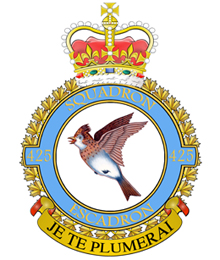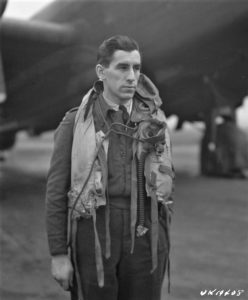 No. 425 Squadron
No. 425 Squadron
Badge: A lark volant
Motto: Je te plumerai (I shall pluck you)
Authority: King George VI, January 1945
The badge is derived from the squadron nickname ‘Alouette’, and the motto comes from the refrain of the French Canadian folk song. The lark is shown in hovering position indicative of a bomber over the target about to strike the enemy.
Formed at Dishforth, Yorkshire, England on 25 June 1942 as the RCAF’s 22nd – fifth Bomber – squadron formed overseas, the unit flew Wellington and Halifax aircraft on strategic and tactical bombing operations. It was a unique formation within the RCAF in that the organization order designated it “French-Canadian” and Bomber Command was combed for French-Canadian air and ground crew to fill its ranks. From June to October 1943, the squadron flew tropicalized Wellington aircraft in North Africa in support of the invasions of Sicily and Italy. After hostilities in Europe it was selected as part of ‘Tiger Force” for duty in the Pacific, converted to Canadian-built Lancaster aircraft, and returned to Canada for reorganization and training. The sudden end of the war in the Far East resulted in the squadron being disbanded at Debert, Nova Scotia on 5 September 1945.
Brief Chronology: Formed at Dishforth, Yorks., Eng. 25 Jun 42. Disbanded at Debert, NS 5 Sep 45.
Title or Nickname: “Alouette” (October 1942)
Adoption: La Presse Newspaper Auxiliary, Montreal, and City of Quebec (March 1945).
Commanders
- W/C J.A.D.B. Richer, DFC 1 Oct 43 – 3 Apr 44 OTE.
- W/C A.R. Mclernon, DFC 4 Apr 44 – 23 May 44.
- W/C J.H.L. Lecomte 24 May 44 – 20 Aug 44.
- W/C H.C. Ledoux 21 Aug 44 – 10 Jun 45.
- S/L L.P.J. Dupuis, DFC 15 Jun 45 – 5 Sep 45.
Higher Formations and Squadron Locations
Bomber Command:
No. 4 Group,
- Dishforth, Yorks. 25 Jun 42 – 31 Dec 42.
No. 6 (RCAF) Group,
- Dishforth, Yorks. 1 Jan 43 – 15 May 43.
- En route to North Africa (1) 16 May 43 – 22 Jun 43.
Mediterranean Air Command:
No. 205 Group,
No. 331 (RCAF) Wing,
- Kairouan/Zina, Tunisia 23 Jun 43 – 29 Sep 43.
- Hani East Landing Ground, Tunisia 30 Sep 43 – 17 Oct 43.
- En route to England (minus aircraft) 26 Oct 43 – 5 Nov 42.
Bomber Command:
No. 6 (RCAF) Group,
No. 61 (RCAF) Base,
- Dishforth, Yorks. 6 Nov 43 – 9 Dec 43.
No. 62 (RCAF) Base,
- Tholthorpe, Yorks. 10 Dec 43 – 12 Jun 45.
- En route to Canada 13 Jun 45 – 14 Jun 45.
RAF “Tiger Force” (for ops),RCAF Eastern Air Command (for training):
No. 6 (RCAF) Group,
No. 663 (RCAF) Wing,
- Debert, N.S. 15 Jun 45 – 5 Sep 45.
Representative Aircraft (Unit Code KW)
Vickers Wellington B.Mk.III (Aug 42 – Apr 43)
- X3364 J X3648 R X3763 E X3803 H X3872 A Z1603 L Z1729 T Z1742 C BJ605 A BJ657 G BJ644 Q BJ755 D BJ783 F BJ894 K BJ918 F BK308 C BK332 0 BK333 N BK334 V BK337 P BK344 B BK401 B BK557 S BK593 S
Vickers Wellington B.Mk.X (England, Apr – May 43)
- HE423 A HE475 E HE486 T HE491 U HE500 C HE592 Q HE955 0 HE655 B HE733 S HE865 K HE901 V HE903 W HZ277 F HE355 D LN409 I MS493 Q
Vickers Wellington B.Mk.X (North Africa, May – Oct 43)
- HEi6o P HE261 R HE267 I HE269 R HE270 K HE329 0 HE330 C HE516 S HE521 V HE522 B HE551 T HE900 E HE930 A HE931 L HE970 C HE976 H HE977 I HE978 X HE979 Y HZ514 Q HZ809 A LN436 D LN440 W MS492 F
Handley Page Halifax B.Mk.III (Dec 43 – May 45)
- LL594 X LL959 K LL596 U LW390 J LW391 N LW412 Q LW413 Q LW414 E LW415 K LW424 T LW428 C LW715 Q MZ418 C MZ419 E MZ454 S MZ602 T MZ815 C MZ954 M NA201 S NA518 G NP999 W NR136 P NR176 R NR271 N
Avro Lancaster B.Mk.X (May – Sep 45, not on operations)
- KB912 Q KB915 H KB916 C KB917 E KB918 P KB924 T KB926 F KB930 N KB931 S KB932 0 KB934 I KB936 G KB944 K KB954 V KB962 D
Operational History: First Mission 5/6 October 1942, 5 Wellington Ill’s from Dishforth despatched to bomb Aachen; 4 bombed the primary target, the fifth what was believed to be Aachen.
Last Mission: 25 April 1945, 18 Halifax Ill’s from Tholthorpe bombed gun positions on the Island of Wangerooge.
Summary Missions/Sorties: 328/3694 (including 88/741 from North Africa.)
- Operational/Non-operational Flying Hours: 20,231/7653.
- Bombs dropped: 9152 tons.
- Victories: Aircraft: 7 destroyed, 1 damaged.
- Casualties:
- Operational: 55 aircraft; 345 aircrew, of whom 37 were killed, 153 presumed dead, 91 POW (of whom 1 escaped), 7 interned, 53 evaded capture or proved safe, 4 missing.
- Non-operational: 11 aircraft; 73 personnel, of whom 64 were killed, 8 injured, 1 died of natural causes.
Honours and Awards: 2 MBE’s, 4 bars to DFC, 63 DFC’s, 2 GM’s, 18 DFM’s, 1 DFC (USA), 4 MiD’s.
Battle Honours:
- English Channel and North Sea 1942-1943.
- Fortress Europe 1942-1944.
- France and Germany 1944-1945: Biscay Ports 1943-1944, Ruhr 1942-1945, Berlin 1944, German Ports 1942-1945, Normandy 1944, Rhine. Biscay 1942-1943. Sicily 1943. Italy 1943: Salerno.
(1) Ground crew by sea, 16-27 May; aircraft took off 5 June. One Wellington (HE268 KW-K) was shot down over the Bay of Biscay and the 7- man crew interned in Portugal. See also No. 331 (Medium Bomber) Wing.
Personnel
Squadron Leader “Eddie” St-Jean, DFC








